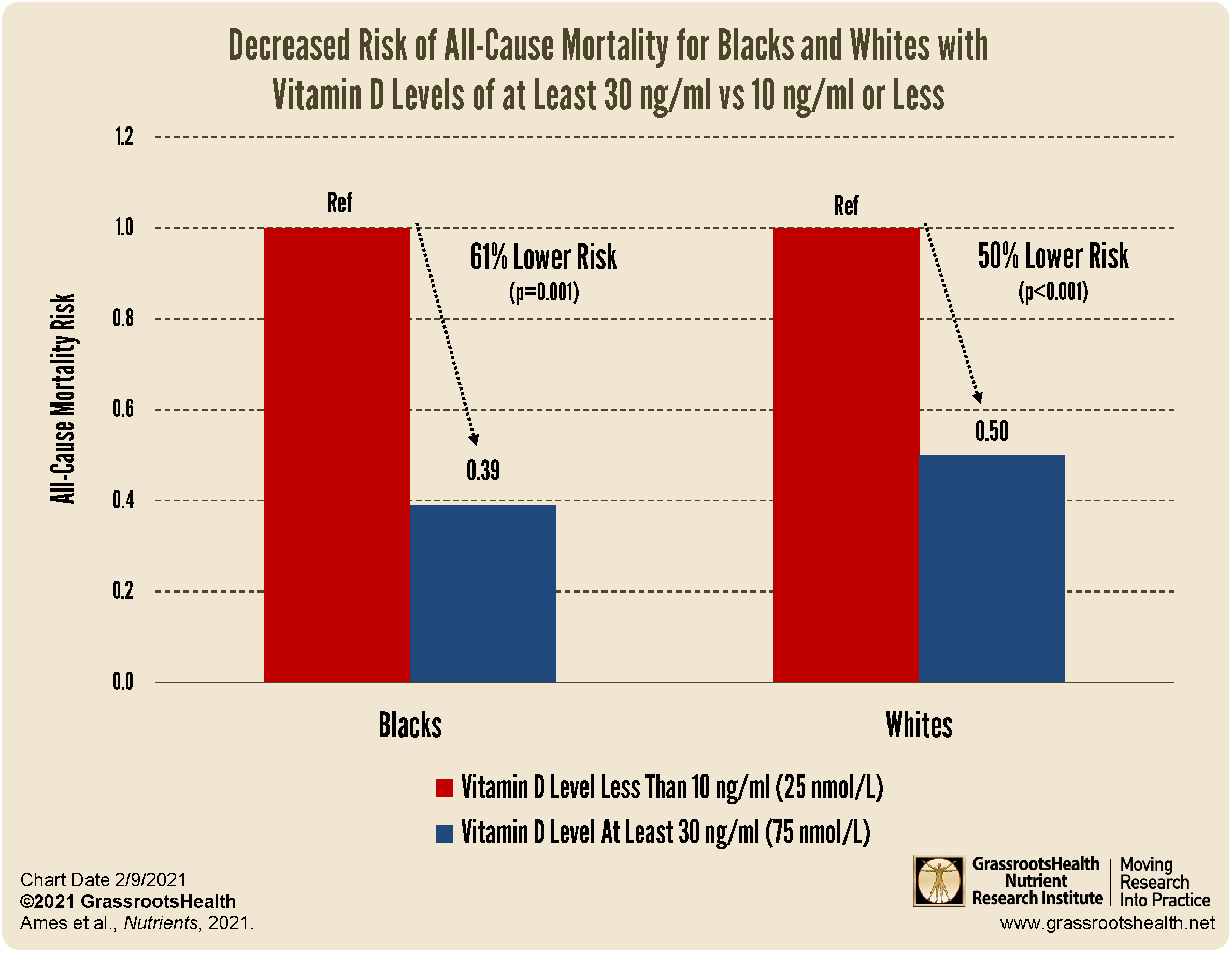Published on April 4, 2022
Mortality risk is similar between blacks and whites when grouped by vitamin D level! Unfortunately, blacks have a 15-20 fold higher prevalence of severe vitamin D deficiency, resulting in increased risk of disease and mortality.
Key Points
- Vitamin D is an extremely important issue for those racial and ethnic minorities with darker skin, as they are more prone to vitamin D deficiency and insufficiency; blacks are the most at risk of deficiency in vitamin D of all ethnicities
- Compared to non-Hispanic whites, the risk of being in the lowest grouping for vitamin D levels is 10 times greater for non-Hispanic blacks, 2.5 times greater for Hispanics, and 3 times greater for other races
- There is strong evidence that just getting vitamin D levels among blacks up to at least 30-40 ng/ml (75-100 nmol/L) may eliminate much of the health disparities seen between blacks and white; one study found a 61% lower risk of mortality for blacks and a 50% lower risk of mortality for whites when vitamin D levels were increased from less than 10 ng/ml (25 nmol/L) to at 30 ng/ml (75 nmol/L) or above

April is National Minority Health Month with a focus on helping to reduce health disparities and improve the health of racial and ethnic minority and American Indian/Alaska Native communities.
Vitamin D is an extremely important issue for racial and ethnic minorities with darker skin. Because of their darker skin color, they are much more prone to vitamin D deficiency and insufficiency (they require more sun exposure than people with lighter skin to make the same amount of vitamin D). Blacks are the most at risk for deficiency in vitamin D of all ethnicities, and many diseases associated with vitamin D deficiency are also the same ones seen more prevalently among blacks.
It should be clear that vitamin D alone has the potential to make a big difference in health outcomes, for black individuals especially. What are we waiting for?
80% Blacks Have Vitamin D Levels below 30 ng/ml (75 nmol/L); 95% below 40 ng/ml (100 nmol/L)
Data from the National Health and Nutrition Examination Survey (NHANES) clearly illustrates the higher rates of vitamin D deficiency among blacks compared to all other ethnicities. Compared to non-Hispanic whites, the risk of being in the lowest grouping for vitamin D levels is
- 10 times greater for non-Hispanic blacks
- 2.5 times greater for Hispanics
- 3 times greater for other races
Blacks also have much Higher Mortality Rates from diseases associated with Vitamin D Deficiency
With more blacks having vitamin D deficiency compared to whites, it should be expected to see more vitamin D deficiency related health conditions, such as cancer, diabetes, heart disease, and others – and mortality due to these conditions – among blacks compared to whites. The chart below illustrates the percent INCREASE in mortality rates for blacks compared to whites.
Getting Vitamin D Levels Among Blacks to 30-40 ng/ml Lowers Black Mortality Rates
A review by Ames et al. titled Does the High Prevalence of Vitamin D Deficiency in African Americans Contribute to Health Disparities? examined the existing research and showed that there is strong evidence that getting vitamin D levels among blacks up to at least 30-40 ng/ml (75-100 nmol/L) may eliminate much of the health disparities seen between blacks and whites. In order to see what effect vitamin D levels had on the mortality rates of blacks compared to whites, the authors created the chart below.
When breaking the mortality risk down by vitamin D level, you can see that the risk of mortality for blacks is similar to the risk of mortality for whites for each category of vitamin D serum level! This indicates that correcting vitamin D deficiency and insufficiency among blacks could close the gap in mortality rates between blacks and whites.
Regardless of Skin Color, Correcting Vitamin D Deficiency Decreases Mortality Risk
Based on the above, the risk of mortality is similar between blacks and whites when mortality is grouped by vitamin D level. Even though more blacks may be in the lower vitamin D categories, with more experiencing higher rates of all-cause mortality, their risk of mortality decreases in the same manner as whites when vitamin D levels increase. As you can see in the chart below, there is a 61% lower risk of mortality for blacks and a 50% lower risk of mortality for whites when vitamin D levels were increased from less than 10 ng/ml (25 nmol/L) to at 30 ng/ml (75 nmol/L) or above.
One simple change can make a BIG difference!
The authors of this review conclude
“…no reason exists to delay addressing vitamin D deficiency among populations with high prevalence of deficiency such as African Americans. The potential benefits promise to be large, and much evidence indicates that the risks of supplementation up to 4000 IU per day vitamin D are minimal.”
Individuals who are black, white, or of any other skin color may greatly benefit their health by checking their vitamin D level and taking the steps necessary to get their vitamin D level up to the scientists’ recommended 40-60 ng/ml (100-150 nmol/L). Take action now!
How Much Vitamin D Do You Need? Find Out with Your Home Test!
 Having and maintaining healthy vitamin D levels and other nutrient levels can help improve your health now and for your future. Choose which additional nutrients to measure, such as your omega-3s and essential minerals including magnesium and zinc, by creating your custom home test kit today. Take steps to improve the status of each of these measurements to benefit your overall health. With measurement you can then determine how much is needed and steps to achieve your goals. You can also track your own intakes, symptoms and results to see what works best for YOU.
Having and maintaining healthy vitamin D levels and other nutrient levels can help improve your health now and for your future. Choose which additional nutrients to measure, such as your omega-3s and essential minerals including magnesium and zinc, by creating your custom home test kit today. Take steps to improve the status of each of these measurements to benefit your overall health. With measurement you can then determine how much is needed and steps to achieve your goals. You can also track your own intakes, symptoms and results to see what works best for YOU.
Enroll in D*action and Test Your Levels Today!








